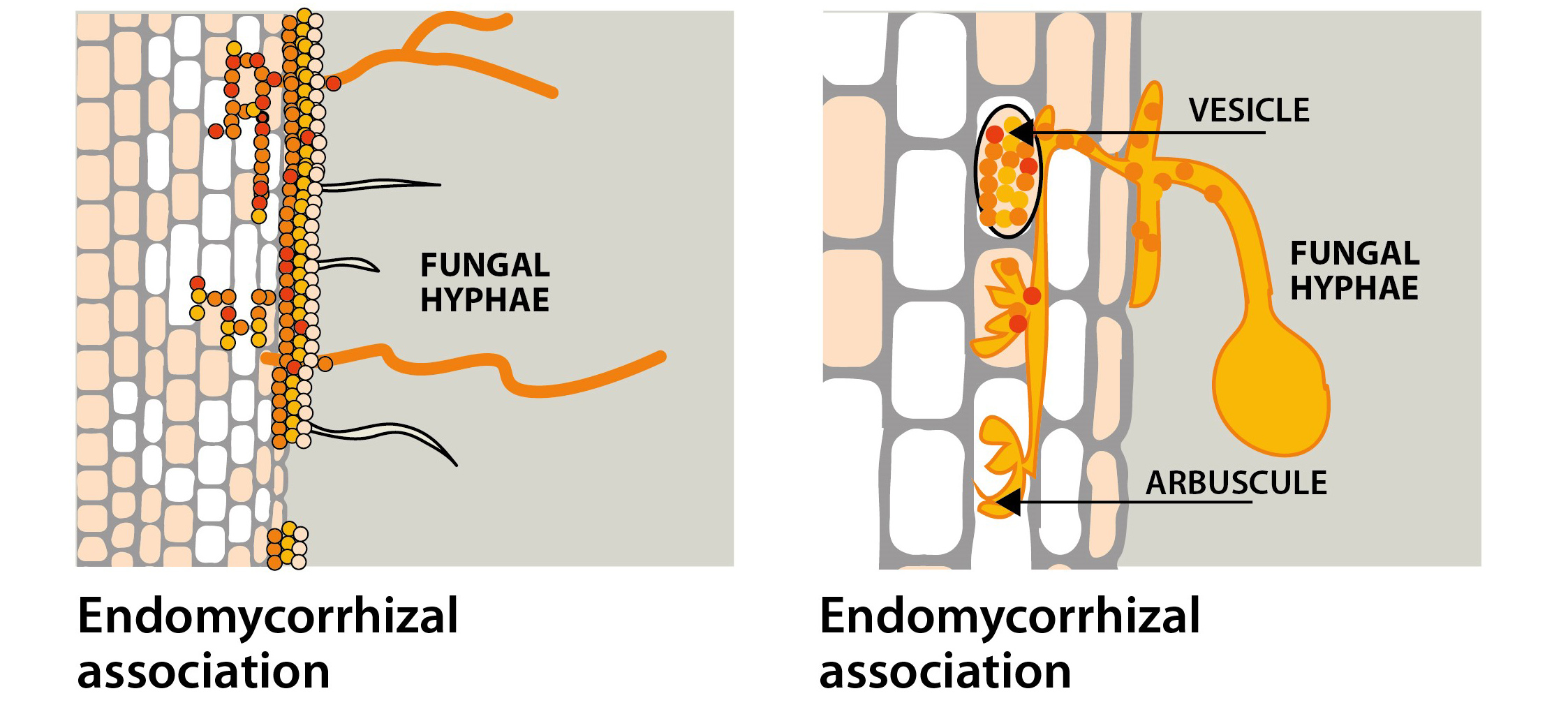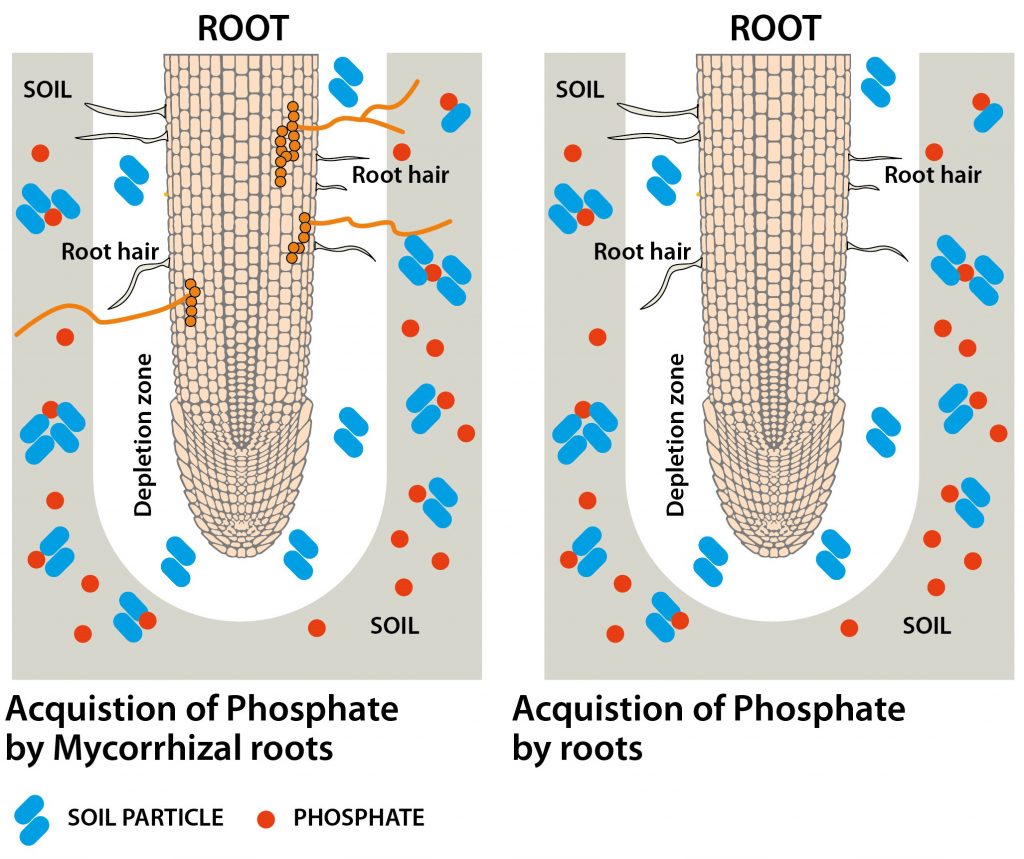
In nature there are numerous great examples of mutualistic interactions, the oldest and best known is perhaps the coral/algae partnership.
In a terrestrial setting the interaction between plants and fungi can be traced to shortly after the first true terrestrial plants evolved. Even simple, early plants such as liverworts and hornworts have been shown to have associated fungal partners as far back as 400 million years ago.
In essence, the evolution and spread of terrestrial plants has always been associated with (and mostly likely enhanced by) their ability to form mutualistic relationships with fungi. The fungi which associate with plant roots are known as mycorrhizal fungi and currently 80-90% of all plants have some type of this interaction, perhaps surprisingly only about 2% of the known fungi show this mycorrhizal partnership.
So, the question must be asked, how and why does this relationship occur and what is its role in plant growth and potential yield?

Let us first look at the fungi, which can be divided into two groups. The first group are those that are free living and are generally known as saprophytic fungi. These fungi are involved in breaking down dead plant and animal material and are absolutely critical in nutrient cycling and derive their energy from the materials they breakdown. The white fungal mass seen on things like mulches or compost are representative of these fungi, as are the fruiting bodies or mushrooms seen in lawns or on dead wood.
The second group are mycorrhizal fungi (mentioned above). These fungi don’t derive their energy source from decaying vegetation but instead are in essence feed by the plants with various sugars and amino acids in exchange for plant nutrients which have been scavenged by the fungi.
Within the mycorrhizal fungi there are two distinct sub-groups, the endomycorrhiza which “invade” the plant roots more deeply than the ectomycorrhizal which in effect form a net around the roots and don’t penetrate the plant root tissue as deeply. The endomycorrhizal interaction is the more common and is found in many of the commercially important crops. Whereas the ectomycorrhizal interaction, is restricted to woody plants and trees.
Interestingly, the specificity of the interaction is much higher for the ectomycorrhizal fungi. This means that the plants will interact only with specific fungal partners, whereas the endomycorrhizal interaction is less restricted.
So, how do plants and fungi establish this type of interaction in the first place? In principle there are two major factors at play, the first is plant derived, here plants secrete what are known as strigolactones. These molecules are a plant hormone and influence a number of plant pathways, however they also enable potential plant mycorrhizal fungi to detect and know the plant is present. In response the fungi secretes what is called as a mycorrhizal factor or myc factor, which is sensed by the plant and this acts effectively a handshake between the two partners. What occurs subsequently is that the plant now allows the fungi to colonise the root of the plant (Fig. 1).
In the case of endomycorrhizal fungi the fungi in effect pushes aside the plant cell membrane within some of the root cells and forms what is known as an arbuscle. This very intimate connection between the plant and the fungi allows the exchange of nutrients and sugars. In the ectomycorrhizal fungi the fungi does not invade the plant cells itself but instead from a filamentous net (Hartig net) around the plants root cells which then allows nutrient exchange similar to the endomycorrhizal fungi (Fig. 2).
In both cases the plant now provides for all of the fungi’s energy requirement. So, why would a plant spend energy firstly recruiting the fungi and then subsequently feed it with valuable sugars? The answer lies in a number of characteristics of the fungi which favour the plants nutrient acquisition and growth as well as protection from pathogens.
Under circumstances where plants lack a fungal partner, nutrient acquisition is limited to the area close to the root and root hairs, this is a zone which can get rapidly depleted of nutrients. However, a plant mutualistic partnership with a fungi greatly increases the ability to obtain, due to the fungi sending out hyphae or in effect mycorrhizal roots. The fungi then takes up nutrients such as nitrogen, phosphate, potassium, and micronutrients such as zinc, iron etc. These are transported to the plant where the fungi then releases these nutrients directly to the plant and in turn the plant contributes sugar to the fungi sugars which the fungi can’t produce itself. On top of this a number of these fungi have the ability to solubilise inorganic phosphate thereby helping the plant to overcome phosphate availability issues (Fig. 3).
Another characteristic of some mycorrhizal fungi is the ability to help plants against pathogens both below and above the ground. Colonisation of the roots would appear to give protection against pathogenic fungi by in effect occupying the same niche and there evidence that mycorrhizal fungi can give some protection against nematodes. There is good data that volatile compounds secreted by these fungi help to attract predatory insects, thereby keeping in check insects which may feed upon the leaves and flowers of the plant. The other aspect of protection relies on changes that occur in the plant when it has a fungal partner, it would appear that the general plant defences are enhanced as the fungi primes the plant thereby increasing the levels of factors know to help in pathogen protection.
Perhaps the most surprising aspect of the plant/fungal partnership comes in the form of both resource sharing between plants and also by the transfer of plant signals between individual species.
Many plants are not only connected to the fungi but, via the fungi are connected to other plants sometimes these are related species other times not. What defines this connectedness is that the fungal partner has to be the same between the different plants. In this way plants have been shown to share nutrients and resources including sugars and even signal each other via this network when under attack by herbivores or pathogens.
Fig. 1: Plant/Fungal interaction allowing the establishment of mutualistic partnership.

Fig. 2: Figure 2: Endo and Ectomycorrhizal interaction.

Fig. 3

In forestry situations not removing every large tree during felling will allow quick establishment of fungal connection to new saplings which greatly increasing their rate or growth and reduces the time to maturity by as much as 20 to 30%. No doubt the plant/fungal mutualistic interaction results in significant increases in plant yield and growth in broad acre, horticulture or forestry. So how do we encourage this fungal plant interaction and maintain the network between plants? The most important step is to ensure the use of organic material, as this encourages diversity of soil microbes both fungal and bacterial and you can’t have these types of interactions unless the soil is healthy and biologically active.
In addition, a reduction in soil disturbance during planting will not only reduce moisture loss but also ensure the fungal network stays intact thereby increasing the chance of your plants benefiting from both readily finding and quickly establishing a fungal partnership.
Dr. Uwe Stroeher
Head of Research and Development
Neutrog Australia
